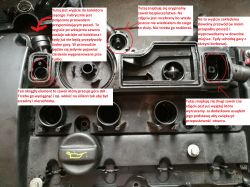Hello.
I'm from 2014. holder of the Peugeot 3008 with 1.6 THP engine which is hailed as the average opinion and has a few weak points. I decided to describe in this topic how I dealt with the dash / separator in this engine.
With 180,000 I decided to do a motor review because I had a significant power drop and a slight jerking which was caused by a large choke in the intake channels and a turbine valve fault. However, after removing the intake manifold, I was disturbed by a large amount of oil (it did not come from a turbine) and throttle on the throttle. After dismantling all the elements of the intake and valve cover I came to the conclusion that the cause lies in the odcept which is integrated with the valve cover. I decided to do something to prevent the vapor system and oil from getting into the intake system, especially when direct injection does not wash the suction valves on which everything is deposited and after a long time causes problems with the engine.
Two wires come out of the valve cover. One of them is directed to the intake manifold and the other to the pipe before the trubo. The modification is that I have blinded the lead wire to the suction manifold and the tube to the turbo. I undressed the lid and rearranged it, blinding one exit and on the other I put a peszel (as a cord) and led it because the car. It is difficult to describe but I took some photos during this work.
1 - This is what the cover after the "detachment" of the plastic cover and the round lid looks like.
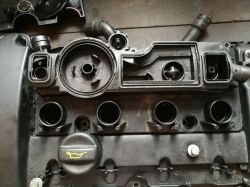
2 - I removed a piece of plastic and made a channel using a finger grinder.
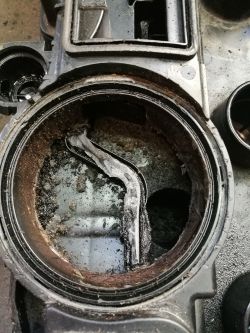
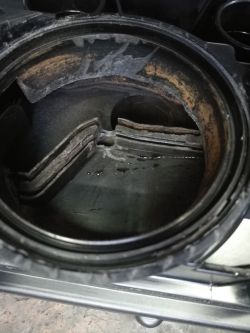
3 - The valve on the left side of the lid (rectangular socket) I took out and cleaned and pasted so that it would not pass through.
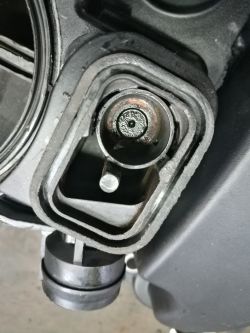
4 - The valve on the right side took out and removed the lighter in which it was located to provide greater freedom of gas flow. I took the picture before removing this slot.
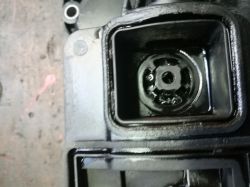
5 - As a vapor separator, I used a dishwashing sponge (from metal chips) which I freely put in a place from which I removed a piece of plastic.
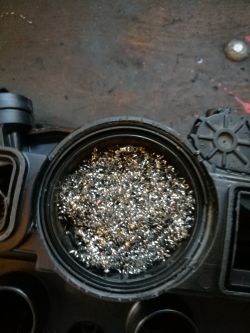
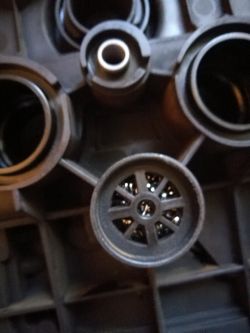
6 - To bind the sealing masses of the victory rantz I have put in a cut of the cover and the entire plastic cover. It is good to take the wire straight away because I later have limited access because the connector is covered by the cover. I used a regular conduit (corrugated pipe) due to the thin wall and thus a small outer diameter in relation to the inner (22mm).

I removed two orange membranes from the cover (one from underneath and the other under a plastic round lid).
Since the modification I beat 2 thousand. km. The engine works nicely, does not take oil, no errors in the computer. From the wire that led out of the cover, it got a mist, but without oil!
I decided to open this topic and get to know all the opinions about this modification.
If someone decides to carry out this modification, he does it at his own risk.
Greetings Przemek.
I'm from 2014. holder of the Peugeot 3008 with 1.6 THP engine which is hailed as the average opinion and has a few weak points. I decided to describe in this topic how I dealt with the dash / separator in this engine.
With 180,000 I decided to do a motor review because I had a significant power drop and a slight jerking which was caused by a large choke in the intake channels and a turbine valve fault. However, after removing the intake manifold, I was disturbed by a large amount of oil (it did not come from a turbine) and throttle on the throttle. After dismantling all the elements of the intake and valve cover I came to the conclusion that the cause lies in the odcept which is integrated with the valve cover. I decided to do something to prevent the vapor system and oil from getting into the intake system, especially when direct injection does not wash the suction valves on which everything is deposited and after a long time causes problems with the engine.
Two wires come out of the valve cover. One of them is directed to the intake manifold and the other to the pipe before the trubo. The modification is that I have blinded the lead wire to the suction manifold and the tube to the turbo. I undressed the lid and rearranged it, blinding one exit and on the other I put a peszel (as a cord) and led it because the car. It is difficult to describe but I took some photos during this work.
1 - This is what the cover after the "detachment" of the plastic cover and the round lid looks like.

2 - I removed a piece of plastic and made a channel using a finger grinder.


3 - The valve on the left side of the lid (rectangular socket) I took out and cleaned and pasted so that it would not pass through.

4 - The valve on the right side took out and removed the lighter in which it was located to provide greater freedom of gas flow. I took the picture before removing this slot.

5 - As a vapor separator, I used a dishwashing sponge (from metal chips) which I freely put in a place from which I removed a piece of plastic.


6 - To bind the sealing masses of the victory rantz I have put in a cut of the cover and the entire plastic cover. It is good to take the wire straight away because I later have limited access because the connector is covered by the cover. I used a regular conduit (corrugated pipe) due to the thin wall and thus a small outer diameter in relation to the inner (22mm).

I removed two orange membranes from the cover (one from underneath and the other under a plastic round lid).
Since the modification I beat 2 thousand. km. The engine works nicely, does not take oil, no errors in the computer. From the wire that led out of the cover, it got a mist, but without oil!
I decided to open this topic and get to know all the opinions about this modification.
If someone decides to carry out this modification, he does it at his own risk.
Greetings Przemek.



